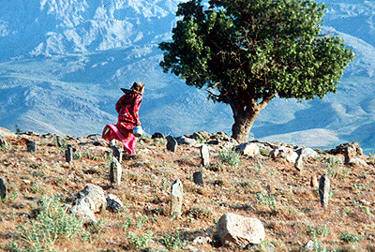 |


|
|
|
|
By John Demetry
 Hope is that The Wind Will Carry Us will finally be the movie to carry its
Iranian director, Abbas Kiarostami, to a wider audience. I doubt it will
succeed at that--how could it in this "Unbreakable" domestic market?
Hope is that The Wind Will Carry Us will finally be the movie to carry its
Iranian director, Abbas Kiarostami, to a wider audience. I doubt it will
succeed at that--how could it in this "Unbreakable" domestic market?
Those lucky enough to see it will either find their love for this director raised to a new level or their introduction to Kiarostami with, perhaps, his most entertaining and brilliant film. It represents a height from which to view the rest of his work in a new light--much as the film itself encourages you to look at life with new clarity. Because the elements that make it such an entertaining and profound cinematic experience are intertwined, it might benefit the uninitiated to focus on what make it so entertaining. Despite what some critics may want you to believe, The Wind Will Carry Us isn't such a daunting experience--saying so makes critics feel smarter, superior than their readers. Kiarostami doesn't suffer from this superiority complex--his film is far too inviting and he shares the creative role of filmmaker with the audience. You could call The Wind Will Carry Us the great leveler. A striking difference from his other films, Kiarostami now features a more expressive lead character, whose sense of modern distress immediately connects with our own. Behzad Dourani plays �The Engineer�, a photographer from Tehran whose come to rural Iran in order to document the burial ritual surrounding the imminent death of a woman over 100 years old.
Thus, themes of old-fashioned ritual and modern communication are put cleverly in place. When an unseen man digs a hole for the telecommuncations project and throws Dowani a buried bone, Dowani uses it to scratch an itch on his leg. While on the hill, Dowani toys with some animals: a dung beetle in Sysiphian struggle with its bounty, a turtle that Dowani flips over with his foot. Although Dowani interacts with a number of people in town, two stand out. Iranian films are notable for their use of adorable children--some feel that this is because it allows their film's political undertones to slip by critics under cover of innocuousness. The young boy that Dowani befriends constitutes, perhaps, the most aesthetically fascinating use of a child actor since Vittorio De Sica's The Bicycle Thief and, in some ways, recalls Charlie Chaplin's The Kid. As with that Italian neo-realist film, the adorable boy serves little narrative purpose. In The Wind Will Carry Us, he is supposed to be Dowani's guide, but he doesn't really help all that much (itself, a running a gag). However, he's a fascinating subject for Kiarostami's camera, and we share Dowani's unarticulated-poetic-appreciation They become friends because of their love of poetry. And Dowani helps him cheat on the exams that distract him from being a helpful guide. Via this relationship the boy becomes the moral-or, rather, aesthetic-center of gravity. (This boy lacks the dramatic technique of Dowani, making their relationship parallel to the film's themes of city and country, art and life.)

Then, there is a village girl who gives him milk, but will never show him her face. Dowani flirts with her by reciting the poem that provides the film with its title, a story of lovers. During this scene-length shot, Kiarostami leaves Dowani off-screen. And even though the girl is on-screen, we also can't see her face in the darkness of the cave, the contours of which are illuminated by the lamp that leaves her face in shadows. A poetic concept of perception is the key to this film's vision of life and of the cinema. As this scene helps illustrate, The Wind Will Carry Us not only marks Kiarostami's most beautiful film to look at, but also his most visually--and, it should be noted, aurally-exciting work. Kiarostami's formal play has never been more rigorous-areas of dramatic interest are often off-screen or hidden on-screen. The more emotionally dynamic lead and the "story" based around his observations of town life coincide with an uncharacteristic use of point-of-view shots. This combined with a constructive editing technique that defines space by placing one image on top of another helps create an intimate appreciation for this town built vertically on the side of a hill. However, this formal rigor finds a kind of shaggy-dog unpredictability in the first-time collaboration between Kiarostami (who also edited the film) and cinematographer Mahmoud Kalari. Kalari has most notably worked with Mohsen Makhmalbaf, my favorite Iranian filmmaker, who is a more visually extravagant director than Kiarostami Makhmalbaf prefers a more expressive style to Kiarostami's formal beauty. Consequently, we get richer colors than ever before in a Kiarostami film combined with ostentatious camera perspectives: one notable shot puts the camera in the place of a mirror while Dowani shaves in close-up and carries on a conversation with a woman in the background. This behind-the-scenes dialectic not only reinvigorates the Kiarostami style, but also allows a new way of expressing his past concerns in its most pure form. For all of Kiarostami's efforts to organize the bits of reality captured on film in a kind of poetic system of structure and repetition, the unpredictability of relationships and of nature ultimately moves unbounded-the source of poetry and of love. As in the poem Dowani recites, Kiarostami and his audience are like the lovers. And the wind carries this film. |

© 1997-2000 BEI